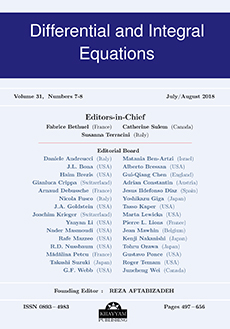Abstract
Fractional calculus is a subject of great interest in many areas of mathematics, physics, and sciences, including stochastic processes, mechanics, chemistry, and biology. We will call an operator $A$ on a Banach space $X$ $\omega$-sectorial ($\omega\in\mathbb R$) of angle $\theta$ if there exists $\theta \in [0,\pi/2)$ such that $S_\theta:=\{\lambda\in\mathbb C\setminus\{0\} : |\mbox{arg} (\lambda)| < \theta+\pi/2\}\subset\rho(A)$ (the resolvent set of $A$) and $\sup\{|\lambda-\omega|\|(\lambda-A)^{-1}\| : \lambda\in \omega +S_\theta\} < \infty$. Let $A$ be $\omega$-sectorial of angle $\beta\pi/2$ with $\omega < 0$ and $f$ an $X$-valued function. Using the theory of regularized families, and Banach's fixed-point theorem, we prove existence and uniqueness of mild solutions for the semilinear fractional-order differential equation \begin{align*} & D_t^{\alpha+1}u(t) + \mu D^{\beta}_t u(t) \\ & = Au(t) + \frac{t^{-\alpha}}{\Gamma(1-\alpha)}u'(0) + \mu \frac{t^{-\beta}}{\Gamma(1-\beta)} u(0) + f(t,u(t)), \,\, t > 0, \end{align*} $0 < \alpha \leq \beta \leq 1,\,\, \mu >0$, with the property that the solution decomposes, uniquely, into a periodic term (respectively almost periodic, almost automorphic, compact almost automorphic) and a second term that decays to zero. We shall make the convention $\frac{1}{\Gamma(0)}=0.$ The general result on the asymptotic behavior is obtained by first establishing a sharp estimate on the solution family associated to the linear equation.
Citation
Valentin Keyantuo. Carlos Lizama. Mahamadi Warma. "Asymptotic behavior of fractional order semilinear evolution equations." Differential Integral Equations 26 (7/8) 757 - 780, July/August 2013. https://doi.org/10.57262/die/1369057816
Information





